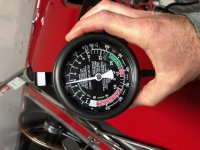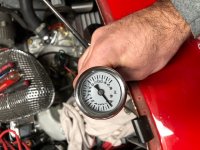OP
Deleted member 19315
Guest
Guest
Offline
Agree with both these points.
 Hi Guest!
Hi Guest!

 smilie in place of the real @
smilie in place of the real @
 Pretty Please - add it to our Events forum(s) and add to the calendar! >> Here's How <<
Pretty Please - add it to our Events forum(s) and add to the calendar! >> Here's How << 
I have two on-off switches (and an inertia fuel cutoff switch) mounted on the heelboard below the rear "seats". Each switch feeds each end of the pump.John--
I have one as well--rebuilt/converted a few years' back by Dave DuBois--and have it wired so that I may select BETWEEN one motor or the other via an "On-Off-On" switch mounted through the bulkhead behind the driver's seat. I assume you have wired your pump so that one of the "On" positions connects both sides of the pump to a hot lead.
Please correct me if I am wrong but--assuming proper motor operation and unimpeded flow--why would running both motors supply more fuel and/or more fuel pressure? I have always assumed that the limitation of flow and pressure is a function of the pump's design and operation and not a lack of power to it.



.
My 2.8 litre 911 on carburettors does about 10 mpg driven briskly and manages on one pump with no starvation issues. I supose a very large capacity motor might need more fuel but have no experience to speak of around very large car engines.
I used to have a -66 Mercedes W111 250 SE Convertible. It had a Bosch Kugelfischer mechanical injection pump (same as in some Porsches from the era) and the standard set-up was a Bosch continuous flow electric pump (virtually bullet-proof, my original pump ran perfectly after 50 years) with a return line to the tank. There was a pressure regulator on the return line that kept the pressure high enough to feed the injection pump. This kept the fuel cold, never any vapour locks. That car was nowhere nearly as attractive as the Austin-Healey, but I must admit that the engineering and parts quality were far superior. That is actually one reason why I sold it, I like to tinker with my cars now and then but the Merc was so problem free that I ran out of things to do once I had sorted the interior and some other issues. I don't seem to get to that point with the Healey, always a little something to fix.
I tell them "It keeps me off the streets."I agree re the tinkering. Neighbors go: "you're always working on your car." I tell them "it's my electric train set: this week I'm taking out the mountain range and putting in a village."


